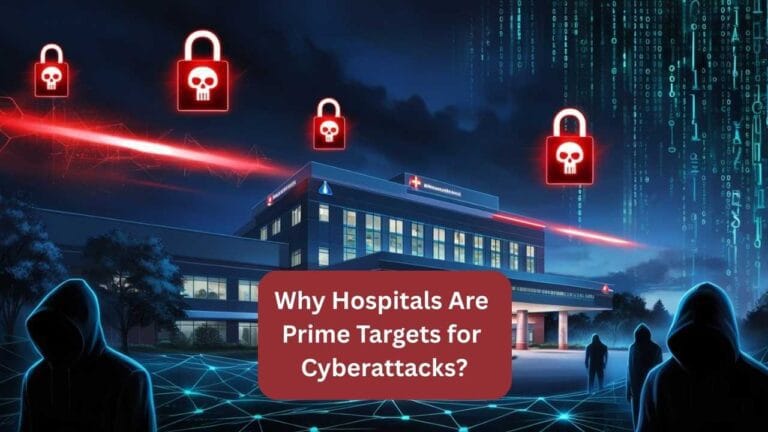Hospitals are under siege, not by viruses, but by hackers. In 2024 alone, healthcare cyberattacks surged by 86%, with ransomware gangs targeting patient records, crippling ER operations, and even delaying life-saving surgeries.
Imagine this: A nurse tries to access a patient’s allergy chart, but the system is frozen. Doctors can’t pull up X-rays. The pharmacy’s medication dispenser flashes “ERROR.” Meanwhile, hackers demand $5 million to restore access. This isn’t a movie plot, it happened to Boston Children’s Hospital in 2023, forcing them to divert critical-care patients.
Hospitals are prime targets for cyberattacks due to the high value of patient data, outdated IT infrastructure, and the critical nature of healthcare services that cannot afford downtime.
Recent years have witnessed a surge in cyberattacks targeting healthcare institutions. According to the U.S. Department of Health and Human Services, there was a 93% increase in significant breaches reported from 2018 to 2022, with ransomware attacks rising by 278% during the same period.
As a cybersecurity consultant who’s helped hospitals recover from breaches, I’ll show you:
- Why hackers see healthcare as “low-hanging fruit”
- The shocking loopholes most hospitals miss
- 3 actionable steps every healthcare provider can take now
Why Are Hospitals Targeted? Here’s What’s Really Happening
Hospitals are cyberattack magnets because they’re a perfect storm of valuable data, outdated systems, and life-or-death urgency that forces quick ransom payments.
The Deadly Equation:
- Data Goldmine: A single health record sells for **
- 250∗∗onthedarkweb(vs.
- 250∗∗onthedarkweb(vs.5 for a credit card), packed with Social Security numbers, insurance IDs, and medical histories perfect for identity theft. (2024 Verizon DBIR Report)
- Outdated Tech: 60% of US hospitals still use Windows 7 or older, despite Microsoft ending security updates in 2020. I recently audited a rural hospital running a 1999 MRI machine with unpatched DOS software.
- No Downtime Tolerance: When hackers encrypted a Midwest hospital’s systems last year, they paid $3.2 million within 12 hours to restore ER operations.
Real-World Example:
“We thought our firewall was enough,” said a CFO I worked with after a ransomware attack. “Then hackers entered through a ventilator’s default password and spread to every ICU monitor.”
The Hidden Weakness Most Hospitals Overlook
It’s not the IT department’s fault, it’s the ‘invisible’ medical devices (IV pumps, heart monitors, etc.) that quietly connect to the network with zero security.
Why This Matters:
- A 2025 JAMA Network study found 53% of networked medical devices have known vulnerabilities.
- MRI machines often ship with factory-set passwords like ‘admin123’, hackers scan for these in minutes.
Actionable Fix:
- Isolate critical devices on separate networks (VLANS).
- Change default credentials on every connected device (use a password manager).
- Monitor device traffic for anomalies (unusual data transfers = early warning).
Myth Debunked: “We’re Too Small to Be Targeted”
“We’re just a community hospital” is the #1 phrase I hear before breaches. Hackers actually prefer smaller targets, they’re easier to infiltrate.
The Reality:
- Supply chain attacks: Hackers breach a small clinic to reach larger partners (like the 2023 McLaren Health breach that started at a dental office).
- Automated bots don’t discriminate: They probe every IP address for weak spots 24/7.
Visualize This:
Think of hospital security like an apartment building. Hackers don’t pick the “best” unit, they jiggle every doorknob until one opens.
3-Step Hospital Cybersecurity Upgrade (30 Days or Less)
Phase 1: Prep (Week 1)
- Conduct a “phishing autopsy”: Send fake emails to staff, 87% of breaches start with human error (2024 HIMSS Report). Train those who fail.
- Patch the “big five”: EHR systems, billing software, nurse call stations, pharmacy databases, and Wi-Fi routers.
Phase 2: Modify (Weeks 2–3)
- Segment networks: Keep medical devices, admin systems, and guest Wi-Fi separate.
- Enforce MFA: Even if hackers get passwords, they can’t bypass Duo or YubiKey.
Phase 3: Progress (Week 4+)
- Run breach simulations: Practice responding to ransomware like a fire drill.
- Partner with a threat intel service: Get real-time alerts on healthcare-specific attacks.
The Human Cost of Complacency
In 2023, an Illinois woman died from a medication error after a ransomware attack forced staff to rely on paper records. Her family is now suing the hospital.
Hospitals must recognize cybersecurity as a critical component of patient safety and healthcare delivery.
The increasing frequency and sophistication of cyberattacks on hospitals underscore the urgent need for robust cybersecurity measures. Protecting patient data and ensuring the continuity of care requires a proactive approach that encompasses technology upgrades, staff training, and strategic planning.AP News
By prioritizing cybersecurity, healthcare institutions can safeguard their operations, maintain patient trust, and fulfill their mission of providing safe and effective care.
Your Next Steps:
- Audit connected devices (start with anything with an IP address).
- Train staff monthly, not just annually (use free NHS Cybersecurity Training modules).
- Assume you’re already breached: Hunt for dormant threats with tools like CrowdStrike Falcon.
“After our breach, we found hackers had been inside our system for 9 months,” a hospital CIO told me. “They’d mapped every exit before striking.”





